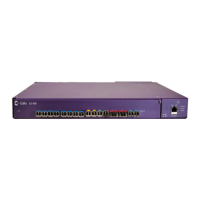34
Proprietary Information: Not for use or disclosure except by written agreement with Calix.
© 2001-2009 Calix. All Rights Reserved.
Wiring Audible and Visual Alarms
Wire the E5-400 audible and visual alarms to a central office alarm system as described
below. Use 26 AWG minimum (19 AWG maximum) wire.
The E5-400 alarm contacts are Normally Open (default). The circuit closes when an alarm
condition occurs.
To wire audible and visual alarms
1. Remove the rear panel access cover by unscrewing its two captive screws and detaching it
from the rear of the chassis.
2. Route and dress three pairs of wires – one pair each for the Major, Minor, and Critical
alarms – from the E5-400 rear panel to the office alarm system.
3. Strip insulation from the ends of the three wire pairs to connect to the unit.
4. On the E5-400 rear panel, connect the alarm wires to the alarm pin fields as follows:
a. Wrap the first pair of wires to the AL0+ and AL0- pins for reporting Critical alarm
activity (Audible).
b. Wrap the second pair of wires to the AL1+ and AL1- pins for reporting Major alarm
activity (Audible).
c. Wrap the third pair of wires to the AL2+ and AL2- pins for reporting Minor alarm
activity (Audible).
d. Wrap the first pair of wires to the AL3+ and AL3- pins for reporting Critical alarm
activity (Visual).
e. Wrap the second pair of wires to the AL4+ and AL4- pins for reporting Critical
alarm activity (Visual).
f. Wrap the third pair of wires to the AL5+ and AL5- pins for reporting Critical alarm
activity (Visual).
5. Optional. If a permanent craft interface is desired, connect a wire wrap pair to the CUTX
and CUTR pins.
6. Optional. If a permanent Ethernet Management Interface connection is desired, connect
a wire wrap pair to the ETX+/ETX- and ERX+/ERX- pairs.
7. Attach the other end of each pair of wires to the appropriate connections on the central
office alarm system following local site practice.
8. Replace and re-attach the rear access cover.
Note: Currently the E5-400 does not provide a power source input failure alarm. In order to
capture input power failure alarms, you can wire an external alarm signal from a rectifier or
breaker panel to any available alarm contacts (for example, AL6 or AL7).

